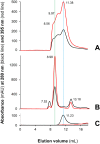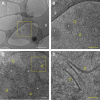Delineating distinct heme-scavenging and -binding functions of domains in MF6p/helminth defense molecule (HDM) proteins from parasitic flatworms
- PMID: 28348084
- PMCID: PMC5448095
- DOI: 10.1074/jbc.M116.771675
Delineating distinct heme-scavenging and -binding functions of domains in MF6p/helminth defense molecule (HDM) proteins from parasitic flatworms
Abstract
MF6p/FhHDM-1 is a small protein secreted by the parasitic flatworm (trematode) Fasciola hepatica that belongs to a broad family of heme-binding proteins (MF6p/helminth defense molecules (HDMs)). MF6p/HDMs are of interest for understanding heme homeostasis in trematodes and as potential targets for the development of new flukicides. Moreover, interest in these molecules has also increased because of their immunomodulatory properties. Here we have extended our previous findings on the mechanism of MF6p/HDM-heme interactions and mapped the protein regions required for heme binding and for other biological functions. Our data revealed that MF6p/FhHDM-1 forms high-molecular-weight complexes when associated with heme and that these complexes are reorganized by a stacking procedure to form fibril-like and granular nanostructures. Furthermore, we showed that MF6p/FhHDM-1 is a transitory heme-binding protein as protein·heme complexes can be disrupted by contact with an apoprotein (e.g. apomyoglobin) with higher affinity for heme. We also demonstrated that (i) the heme-binding region is located in the MF6p/FhHDM-1 C-terminal moiety, which also inhibits the peroxidase-like activity of heme, and (ii) MF6p/HDMs from other trematodes, such as Opisthorchis viverrini and Paragonimus westermani, also bind heme. Finally, we observed that the N-terminal, but not the C-terminal, moiety of MF6p/HDMs has a predicted structural analogy with cell-penetrating peptides and that both the entire protein and the peptide corresponding to the N-terminal moiety of MF6p/FhHDM-1 interact in vitro with cell membranes in hemin-preconditioned erythrocytes. Our findings suggest that MF6p/HDMs can transport heme in trematodes and thereby shield the parasite from the harmful effects of heme.
Keywords: Fasciola; MF6p/FhHDM-1; MF6p/HDM; cell-penetrating peptide (CPP); fluke; heme; homeostasis; oligomerization; parasite; trematode.
© 2017 by The American Society for Biochemistry and Molecular Biology, Inc.
Conflict of interest statement
The authors declare that they have no conflicts of interest with the contents of this article
Figures













Similar articles
-
Fasciola spp: Mapping of the MF6 epitope and antigenic analysis of the MF6p/HDM family of heme-binding proteins.PLoS One. 2017 Nov 21;12(11):e0188520. doi: 10.1371/journal.pone.0188520. eCollection 2017. PLoS One. 2017. PMID: 29161330 Free PMC article.
-
The MF6p/FhHDM-1 major antigen secreted by the trematode parasite Fasciola hepatica is a heme-binding protein.J Biol Chem. 2014 Jan 17;289(3):1441-56. doi: 10.1074/jbc.M113.499517. Epub 2013 Nov 26. J Biol Chem. 2014. PMID: 24280214 Free PMC article.
-
An immunoregulatory amphipathic peptide derived from Fasciola hepatica helminth defense molecule (FhHDM-1.C2) exhibits potent biotherapeutic activity in a murine model of multiple sclerosis.FASEB J. 2025 Feb 28;39(4):e70380. doi: 10.1096/fj.202400793RR. FASEB J. 2025. PMID: 39950309 Free PMC article.
-
Fasciola hepatica-Derived Molecules as Regulators of the Host Immune Response.Front Immunol. 2020 Sep 2;11:2182. doi: 10.3389/fimmu.2020.02182. eCollection 2020. Front Immunol. 2020. PMID: 32983184 Free PMC article. Review.
-
A mysterious family of calcium-binding proteins from parasitic worms.Biochem Soc Trans. 2016 Aug 15;44(4):1005-10. doi: 10.1042/BST20150270. Biochem Soc Trans. 2016. PMID: 27528745 Review.
Cited by
-
Schistosoma mansoni immunomodulatory molecule Sm16/SPO-1/SmSLP is a member of the trematode-specific helminth defence molecules (HDMs).PLoS Negl Trop Dis. 2020 Jul 9;14(7):e0008470. doi: 10.1371/journal.pntd.0008470. eCollection 2020 Jul. PLoS Negl Trop Dis. 2020. PMID: 32644998 Free PMC article.
-
Modulation of Host Immunity by Helminths: The Expanding Repertoire of Parasite Effector Molecules.Immunity. 2018 Nov 20;49(5):801-818. doi: 10.1016/j.immuni.2018.10.016. Immunity. 2018. PMID: 30462997 Free PMC article. Review.
-
Opisthorchis viverrini Proteome and Host-Parasite Interactions.Adv Parasitol. 2018;102:45-72. doi: 10.1016/bs.apar.2018.06.002. Epub 2018 Jul 18. Adv Parasitol. 2018. PMID: 30442310 Free PMC article. Review.
-
Increased specificity of Fasciola hepatica excretory-secretory antigens combining negative selection on hydroxyapatite and salt precipitation.Sci Rep. 2024 Feb 16;14(1):3897. doi: 10.1038/s41598-024-54290-8. Sci Rep. 2024. PMID: 38365880 Free PMC article.
-
Fasciola spp: Mapping of the MF6 epitope and antigenic analysis of the MF6p/HDM family of heme-binding proteins.PLoS One. 2017 Nov 21;12(11):e0188520. doi: 10.1371/journal.pone.0188520. eCollection 2017. PLoS One. 2017. PMID: 29161330 Free PMC article.
References
-
- Ashrafi K., Bargues M. D., O'Neill S., and Mas-Coma S. (2014) Fascioliasis: a worldwide parasitic disease of importance in travel medicine. Travel Med. Infect. Dis. 12, 636–649 - PubMed
-
- Haçarız O., Sayers G., and Baykal A. T. (2012) A proteomic approach to investigate the distribution and abundance of surface and internal Fasciola hepatica proteins during the chronic stage of natural liver fluke infection in cattle. J. Proteome Res. 11, 3592–3604 - PubMed
-
- Mulvenna J., Sripa B., Brindley P. J., Gorman J., Jones M. K., Colgrave M. L., Jones A., Nawaratna S., Laha T., Suttiprapa S., Smout M. J., and Loukas A. (2010) The secreted and surface proteomes of the adult stage of the carcinogenic human liver fluke Opisthorchis viverrini. Proteomics 10, 1063–1078 - PMC - PubMed
-
- Cao X., Fu Z., Zhang M., Han Y., Han Q., Lu K., Li H., Zhu C., Hong Y., and Lin J. (2016) Excretory/secretory proteome of 14-day schistosomula, Schistosoma japonicum. J. Proteomics 130, 221–230 - PubMed
Publication types
MeSH terms
Substances
LinkOut - more resources
Full Text Sources
Other Literature Sources

